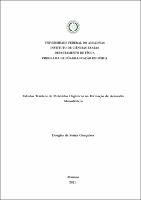| ???jsp.display-item.social.title??? |


|
Please use this identifier to cite or link to this item:
https://tede.ufam.edu.br/handle/tede/8858| ???metadata.dc.type???: | Tese |
| Title: | Estudos teóricos de moléculas orgânicas na formação de aerossóis atmosféricos |
| Other Titles: | Theoretical Studies of Organic Molecules in Atmospheric Aerosol Formation |
| ???metadata.dc.creator???: | Gonçalves, Douglas de Souza  |
| ???metadata.dc.contributor.advisor1???: | Chaudhuri, Puspitapallab |
| First advisor-co: | Coutinho, Kaline Rabelo |
| ???metadata.dc.contributor.referee1???: | Moreno, Roberto Rivelino de Melo |
| ???metadata.dc.contributor.referee2???: | Georg, Herbert de Castro |
| ???metadata.dc.contributor.referee3???: | Sanches, Edgar Aparecido |
| ???metadata.dc.contributor.referee4???: | Gusmão, Marta Silva dos Santos |
| ???metadata.dc.description.resumo???: | A presença dos aerossóis na atmosfera é considerada como um dos fatores responsáveis pelas mudanças climáticas que estão ocorrendo ao redor do mundo. Há um consenso de que a formação de aerossóis atmosféricos (AA's) se inicia a partir das interações entre certas moléculas atmosféricas, por exemplo o H2SO4 e H2O. Essas moléculas são conhecidas como precursores atmosféricos de nucleação (PAN's) e formam aglomerados moleculares estabilizados por ligações de hidrogênio. Porém, ainda existem dúvidas sobre a composição exata desses aglomerados, a natureza das ligações intermoleculares e as contribuições de diferentes componentes, principalmente de moléculas orgânicas, no fortalecimento e crescimento desses aglomerados na formação de novas partículas. No presente trabalho, aplicamos modelos quânticos baseados em DFT e simulação clássica para investigar as interações de MSA e alguns aminoácidos com PAN's. O trabalho foi desenvolvido em fase gasosa, importante para entender o processo inicial da formação dos AA's e em solução, o que é importante na formação de núcleos de condensação de nuvens. As ligações de hidrogênio foram caracterizadas usando parâmetros energéticos e vibracionais, junto com ferramentas da teoria quântica de átomos em moléculas. A análise das energias de ligação indicam que o MSA de fato traz uma estabilidade adicional para os aglomerados com H2SO4 e as temperaturas e pressões mais baixas em maiores altitudes da troposfera, favorecem a formação dos aglomerados de MSA(H2SO4)n. Análises das propriedades eletrônicas demostram que a taxa de espalhamento elástico de luz aumenta com o crescimento desses aglomerados e, a solvatação deles, demonstra a capacidade desses sistemas em condensar água em sua superfície. Estendendo a análise de solvatação para aminoácidos, analisamos a distribuição e energia livre de solvatação para a glicina, alanina e valina, o que indicou uma estrutura com maior presença da valina na região de interface, seguida da alanina e, por fim, a glicina, cuja energia livre indica a preferência pela região de bulk. |
| Abstract: | The presence of aerosols in the atmosphere is considered to be one of the factors responsible for the climate changes occurring around the world. There is a consensus that the formation of atmospheric aerosols (AA's) initiates from the interactions between certain atmospheric molecules like H2SO4 and H2O, collectively called as atmospheric nucleation precursors (ANP) forming hydrogen-bonded molecular clusters. However, there exist doubts about the exact composition of these molecular clusters, the nature of the intermolecular interactions and the contributions of different components, mainly organic molecules, in strengthening and growth of these clusters leading to the formation of new particles. In the present work, we applied DFT-based quantum-chemical models and classical simulation to investigate the interactions of MSA and some amino acids with ANP's. The work was developed in the gas phase, which is important to understand the initial process of formation of AA's, then in the presence of water molecules, which is important regarding the formation of cloud condensation nuclei and, finally, we analyze the spatial distribution and free energy of solvation of amino acids like glycine, alanine and valine. The hydrogen bonds were characterized using energetic and vibrational spectroscopic parameters along with the tools of quantum theory of atoms in molecules. Analyses of the binding energies of the clusters indicate that MSA indeed brings additional stability to the clusters with H2SO4 and the lower temperatures and pressures at higher altitudes of the troposphere favor the formation of MSA(H2SO4)n clusters. Analyses of the electronic properties show that the elastic scattering of light increases many times when it interacts with the clusters. The simulation of the solvent effect demonstrated the capacity of these clusters to condense water on their surfaces. Extending the solvation analysis to the amino acids we observe that the three amino acids considered for this work showed difference in their distribution inside the solvent, with valine having greater presence at the air-water interface, followed by alanine and finally glycine, whose free energy indicates a preference for the bulk region. |
| ???metadata.dc.subject.cnpq???: | CIENCIAS EXATAS E DA TERRA: FISICA: FISICA ATOMICA E MOLECULAR: ESTRUTURA ELETRONICA DE ATOMOS E MOLECULAS TEORIA |
| ???metadata.dc.subject.user???: | Aerossol Atmosférico Precursores Atmosféricos de Nucleação Ácido Metanossulfônico Ligação de Hidrogênio DFT QTAIM Simulação de Monte Carlo |
| Language: | por |
| ???metadata.dc.publisher.country???: | Brasil |
| Publisher: | Universidade Federal do Amazonas |
| ???metadata.dc.publisher.initials???: | UFAM |
| ???metadata.dc.publisher.department???: | Instituto de Ciências Exatas |
| ???metadata.dc.publisher.program???: | Programa de Pós-graduação em Física |
| Citation: | GONÇALVES, Douglas de Souza. Estudos teóricos de moléculas orgânicas na formação de aerossóis atmosféricos. 2022. 132 f. Tese (Doutorado em Física) - Universidade Federal do Amazonas, Manaus (AM), 2021. |
| ???metadata.dc.rights???: | Acesso Aberto |
| ???metadata.dc.rights.uri???: | http://creativecommons.org/licenses/by-nc-nd/4.0/ |
| URI: | https://tede.ufam.edu.br/handle/tede/8858 |
| Issue Date: | 17-Sep-2021 |
| Appears in Collections: | Doutorado em Física |
Files in This Item:
| File | Description | Size | Format | |
|---|---|---|---|---|
| Tese_DouglasGoncalves_PPGFIS.pdf | 20.96 MB | Adobe PDF |  Download/Open Preview |
This item is licensed under a Creative Commons License





